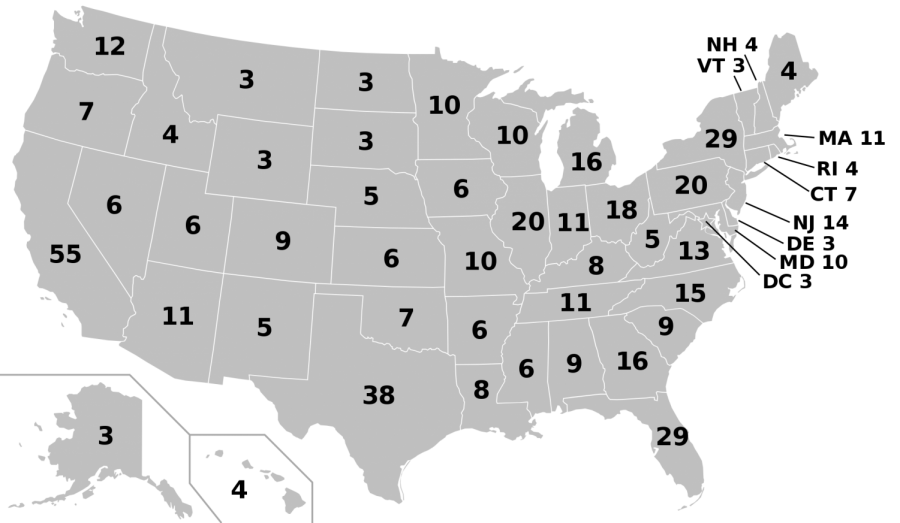Why The Electoral College Is Flawed
And Why The Popular Vote Is A Little Better

Electoral college map for the 2012, 2016 and 2020 United States presidential elections, using apportionment data released by the US Census Bureau
The Founding Fathers approved the idea of the Electoral College at the Constitutional Convention in 1787. It is described in Article II Section I of the Constitution.
How Does It Work?
Unlike many other countries, the United States does not choose their leader by a simple popular vote. Instead, the President is elected by 538 electors. Each state is designated a certain number of electors based on how many members they each hold in The House and Senate. For example, Illinois has two Senators and 18 House Representatives. Therefore Illinois is given 20 electoral votes. To become president, a candidate must earn at least 270 electoral votes. If no candidate reaches that benchmark, it goes to the House, where representatives decide who will become president.
Here is an interactive Electoral map that can help illustrate the process.
Who Are Electors?
An elector is a person who is usually either chosen by their party’s state committees or conventions. In an election, each party chooses electors. Depending on which party wins the majority vote of that state, that party’s electors get to vote. In 2016, when Hilary Clinton won 55% of the vote in Illinois, the 20 electors chosen through the Democratic party’s state conventions and committees got to vote for their candidate
What Is Wrong With The Electoral College?
There are many critiques that have been made about the controversial system. However, arguably the most notable and talked about, is the weight of one’s single vote. With how the system is set up, a citizen’s vote has a different weight depending on the state or district they live in.
For example, Illinois, with a population of 12.7 million and 20 electoral votes, gets an electoral vote for approximately every 635,000 citizens. Montana, with a population of 1.08 million and 3 electoral votes, gets an electoral vote for about every 360,000 citizens. Why does Illinois need so many more people per electoral vote?
There are two main reasons this imbalance occurs…
Reason #1
The first has to do with the Senate. As mentioned above, a state is given electoral votes based on their total amount of representatives in Congress. As opposed to the House, the amount of representatives each state receives in the Senate isn’t based off population. Each state receives two Senators regardless of their population.
Since Senators are counted toward a state’s amount of electoral votes, states with smaller populations receive more power. Take the most and least populous states for example. California, with a population of around 40 million, has 53 House Representatives and two Senators, for a total of 55 electoral votes.. Wyoming, with a population of almost 600,000, has one House Representative and two Senators, for a total of 3 electoral votes.
The addition of Senators to the count of electoral votes more greatly helps Wyoming than California. Since Wyoming only has one Representative, the adding of the two Senators triples their amount of electoral votes. On the other hand, because California already has so many Representatives, the adding of the two Senators to their total doesn’t impact them as much. Due to Senators, the number of Wyoming’s electoral votes increase by 300%, while California’s electoral votes only increase by around 4%.
This hurts bigger states and helps smaller states. When it comes to the amount of electoral votes a state gets, smaller states have a larger proportion of their electoral votes that are not tied to their true population. In California, 96% (53/55) of their electoral votes are actually connected to members of House Representatives, which more closely relates to population than Senators. In Wyoming, 33% (1 / 3) of their electoral votes are actually connected to their House Representatives.
Reason #2
The second reason that Americans votes are weighted differently, has to do with The House of Representatives. Although the amount of representatives each state receives is based on population, the system is not perfect. This is partly due to the size of the country. With over 300 million citizens, it is impossible to perfectly emulate the population of a country from state to state, with one representative body. Secondly, according to the Constitution, every state gets at least one Representative, no matter their size. Although this law is clearly needed, it creates further imbalance when election day comes.
Depending on the state, there are a different amount of citizens per representative. In Illinois, there are 12.7 million citizens and 18 House Representatives. In Wyoming, there are 572,000 citizens, and one House Representative. This puts Illinois at around 706,000 citizens per Representative. In this example, it is quite evident, that Illinois needs more people to earn one electoral vote compared to Wyoming.
This is not unique to just Illinois and Wyoming. Every state and Washington, D.C. has a slightly different citizens to representative ratio.
Since House Representatives contribute to a state’s total number of electoral votes, the state to state differing ratios between representatives expands the issue.
What’s Wrong With A Pure Popular Vote?
Although a popular vote would correct the current issue of citizens’ votes being weighted differently, it opens an additional risk.
Many Republicans argue against converting to a popular vote. In a video from the popular conservative YouTube channel, PragerU, Tara Ross states that “in a pure democracy, bare majorities can easily tyrannize a country.”
This is a valid concern. Although extremely unlikely, there are situations in which candidates can win the popular vote, without having a single vote from a majority of states.
In the 2016 election, there were around 130 million votes that went to the two leading Candidates. Hilary Clinton actually won the popular vote, with 65.85 million votes. Donald Trump received only 62.99 million votes, but won the electoral college by a rather large margin.
In the 2016 election, Hilary won the popular vote with just under 66 million votes. In that election, the top ten most populous states contributed over 68 million votes to the top two candidates. That technically means that either candidate could have won the popular vote, without having a single supporter in 40 states. This scenario will likely never happen, because it requires candidates to have nearly 100% in 10 states.
The issue of “bare majority” can also be illustrated in a more realistic example. In the 2016 election, the 20 most populous states gave about 97 million votes out of the 130 million to the top two candidates. This means that Clinton or Trump could have received 60% support in the 20 most populous states, and 0% support in the other 30 states, and could have still won the popular vote. Although it is imaginable that a candidate could receive 60% in the 20 most populous states, a candidate will most likely never receive 0% in 30 states. If a candidate receives 60% in 20 states, it can be assumed they would be relatively competitive in the other 30.
In the 2016 election, neither Clinton nor Trump got anywhere close to 100% support in any of the top ten most populated states. The closest any candidate got was in California. Hilary was able to get 61.5%, while Trump received 31.5% in the state. In the other nine most populous states, no candidate was even close to 100%
What about a candidate receiving 60% in the top 20 most populous states? Neither candidate was very close to that scenario either. In 2016, Hilary Clinton received 60% support in three of the 20 most populous states (California, Maryland, and Massachusetts). Donald Trump only received 60% in one of the 20 most populous states (Tennessee).
Which One Is Better?
Both the Electoral College and the popular vote have flaws. However, it appears that the imbalance the Electoral College causes in the individual worth of a vote is the biggest problem. Everybody’s vote in a country should be worth the same amount. A national popular vote would fix this problem. Although the national popular vote could “tyrannize a country” as Tara Ross put it, the threat of that appears minimal.
The scenarios for tyranny to occur are extremely unlikely as proved above. In 2016, no candidate was even close to achieving a scenario that would allow for a “bare majority” to threaten our democracy. It is not feasible that a candidate would get so much of the popular vote in one state and close to none in another, which is clearly shown based on the country’s conditions today.
However, by no means, are those scenarios impossible. Extremes can most certainly lead to a super majority taking advantage of a minority.
In the country today though , the threat of a “bare majority” is greatly outweighed by the constant imbalance of an individual’s vote, that occurs every four years because of the Electoral College.
Which do you think is a better system? Post your ideas in the comments.

Grant Preves is a senior and is on news team for his third year. He has enjoyed co-hosting The Howl and having political debates with fellow news team...



